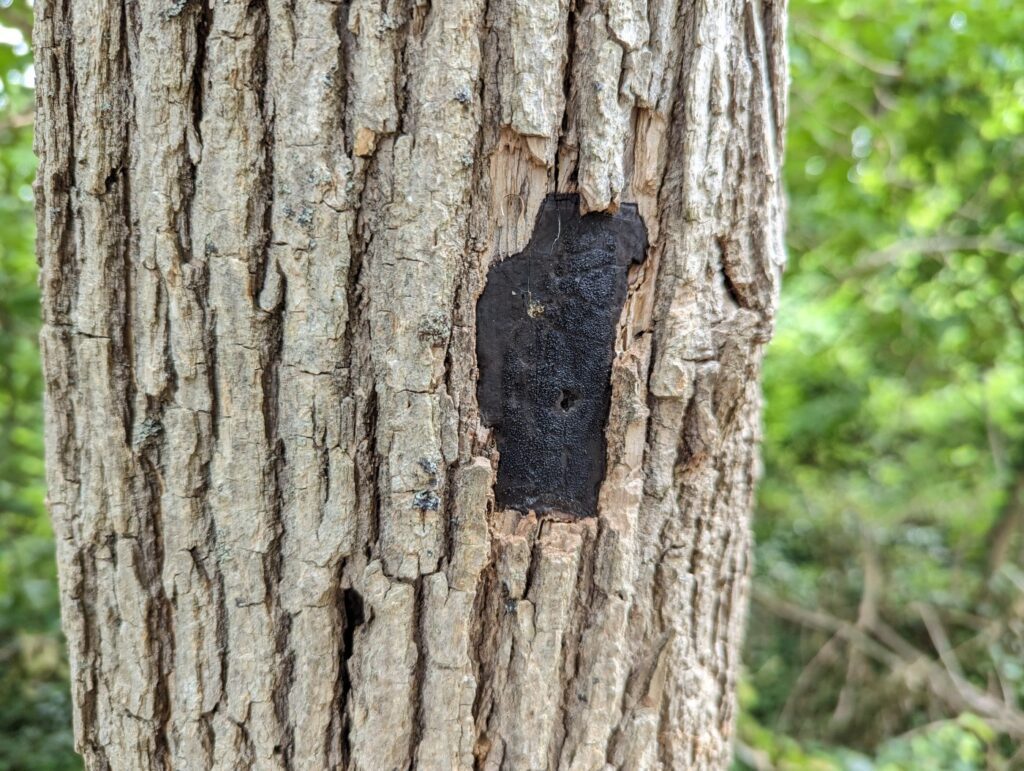Garden Q&A: What is this black residue on my tree trunk?
- December 7, 2023

Q: I recently noticed a black, tar-like patch on my tree trunk, though it’s not tacky like actual tar. Are these insect eggs? Dried sap? Do I try to scrape it off? The tree has lichen but I don’t think they’re ever black like this.
A: Lichen can occur in a range of colors, but you are correct, this is not lichen, nor is it tree sap or insect eggs; the flat patches, flush with the bark or just below bark level, indicate something else. Unfortunately, it’s probably an indication of a tree health problem that can’t be cured — a fungal infection and the onset of wood decay.
Similar to people, when trees are experiencing stress, they can become more vulnerable to a range of opportunistic pest and disease issues, since mounting a successful defense would tax their already-strained resources. A common stressor is drought, though compacted and poorly-drained soil, especially coinciding with excess rainfall or irrigation, can also result in root death or poor root function. Since healthy roots are critical for a tree’s absorption of moisture and nutrients, it’s easy to see how their decline can create the potential for a downward spiral in tree health.
In your case, the black substance looks like hypoxylon (now classified as biscogniauxia), a fungal disease that causes cankers (lesions) and dieback. Some species of oak are more prone to attack than others, though other species of shade tree can also be infected. Interestingly, this widespread fungus can live on/in healthy trees for a long time without causing damage, but when a tree becomes stressed, the organism can turn pathogenic. Summer heat waves might not only benefit colonies of the fungus already present in wood, but also could increase the risk of tree infection overall — one of the many impacts of climate change on forest health.
By the time the stroma (the visible mat of fungal tissue that spreads spores) turns black, the disease has probably been progressing for months, even if canopy dieback symptoms seem to be sudden. Nothing can salvage a tree infected with hypoxylon in its trunk, though nearby trees are not necessarily at high risk if they are not seriously wounded or stressed. Have an arborist or licensed tree expert evaluate trees if you are concerned about their health and vulnerability. Oklahoma State University Extension’s page Biscogniauxia (Hypoxylon) Canker and Dieback of Trees provides more information about this common fungus.
Q: What might be a creative gardening gift for someone who only has a balcony or small deck and wants fresh vegetables?
A: Container gardening with edibles can be challenging, since limited space hampers what you can grow and how much of a crop the plants can provide. If the site receives full sun in summer (best for the highest productivity and to support plant health), you can build a simple Salad Box if you’re crafty or have a friend with some tools and construction space to borrow. Starting small if the recipient is not experienced in growing food crops is a good entry point to later experimenting with a raised bed in a community garden (or a garden plot in their own yard someday).
A Salad Box is a small tray-like box used for growing salad greens like lettuce, other leafy greens, or compact-growing herbs. A Salad Table is the next step up to give someone more room and opportunity to expand their crop selection, though of course it requires more space and would probably only fit on a larger balcony or deck. (Always be mindful of structural weight limitations.)
For design ideas, you can explore our pages Building a Salad Box and Building a Salad Table, plus the links within them for more information about plant selection, care, and harvesting. Our Types of Food Gardens collection of web pages includes additional tips for general container gardening for vegetables, creating self-watering containers (such as using 5-gallon buckets), and community gardens. (Wouldn’t it be wonderful if more apartment-heavy developments set aside land for a community garden for the residents?)
University of Maryland Extension’s Home and Garden Information Center offers free gardening and pest information at extension.umd.edu/hgic. Click “Ask Extension” to send questions and photos.
Most Viewed
More
- AandE
- Allegheny
- Books
- Celebrities
- Celebrity News
- Editors Picks
- Health Now
- Local
- MLB
- Monroeville
- More A and E
- Most Recent Obituaries
- Movies TV
- Murrysville
- Music
- News
- News & Advice
- NFL
- NHL
- Norwin
- Penn Hills
- Pirates
- Pittsburgh
- Plum
- Politics Election
- Sports
- Steelers
- Theater Arts
- Top Stories
- Tribune Review Obituaries
- US-World
- Valley News Dispatch
- Westmoreland
- World